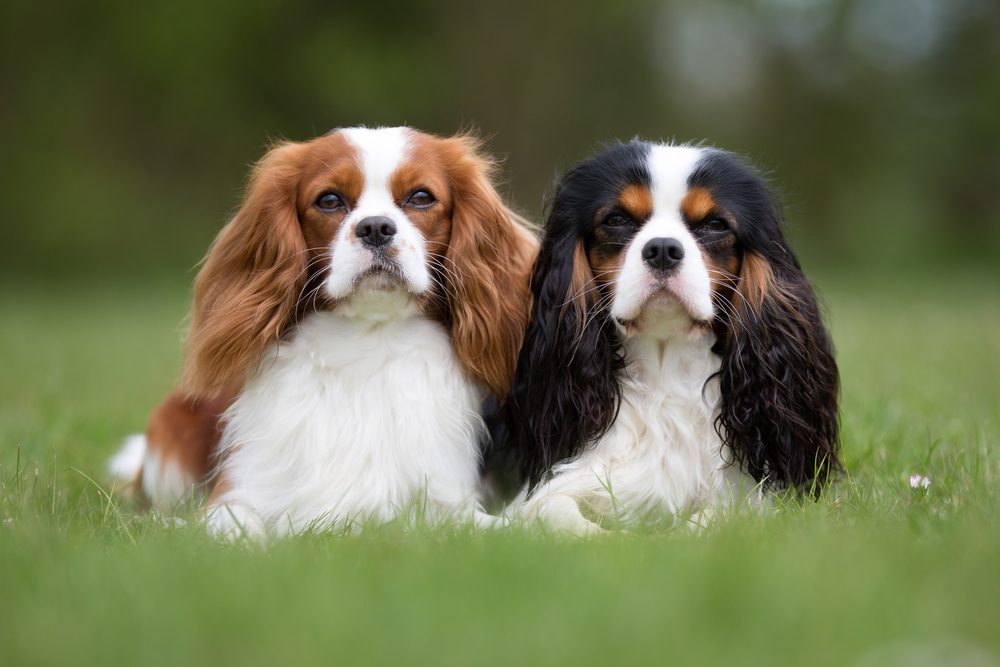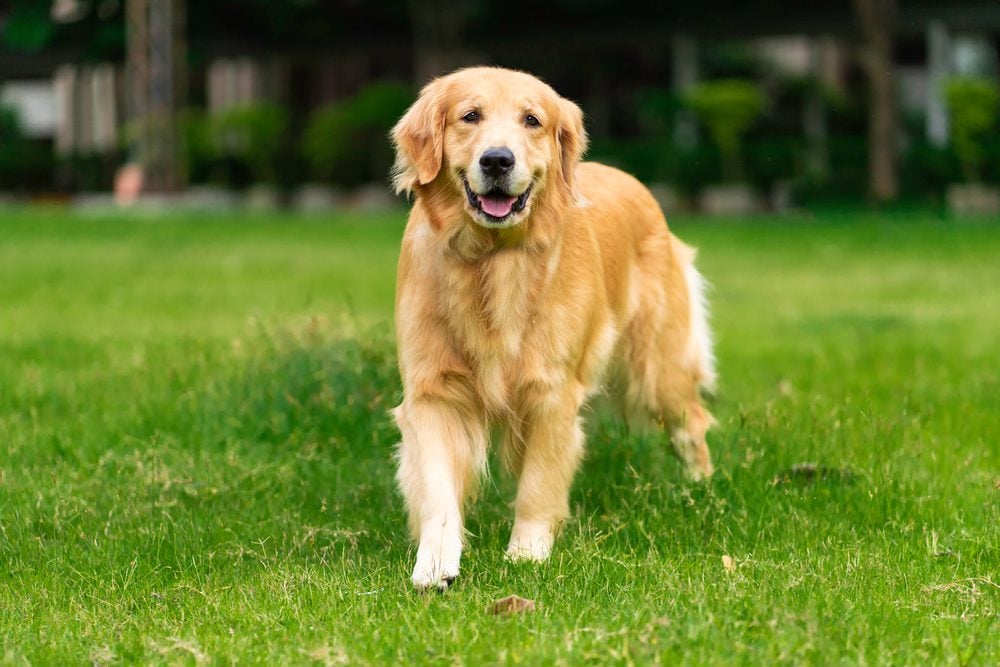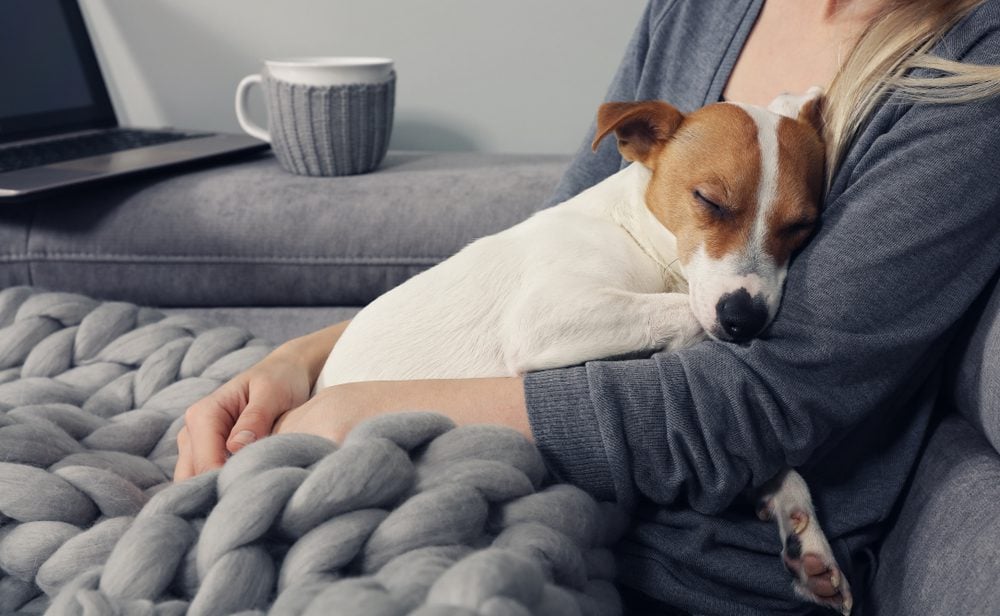Depression is often a daily struggle, and there are many different types of treatments, such as therapy and medication. Believe it or not, owning a dog can also be beneficial for those who suffer from depression.
Though a dog cannot magically cure one’s depression, it can help one cope with it. Dogs provide comfort through unconditional love as well as a list of other benefits.
In this article, we’ll explain how dogs can help people with depression, discuss the different types of support dogs, and offer recommendations of some of the best dog breeds for depression.
How Dogs Can Help
There are many different ways dogs can help people suffering from depression. In fact, there have been a number of scientific studies on the subject.
One such study found that pets, including dogs, caused their owners’ oxytocin levels to increase. Oxytocin has antidepressive effects and therefore is very beneficial to anyone struggling with depression.
Other studies indicate that dogs have the ability to lower stress. A study published in 2019 had college students pet dogs. After just 10 minutes of petting, the students’ cortisol (stress hormone) levels had lowered.
Similarly, a dog’s presence has been found to lower their owners’ stress more effectively than the presence of a spouse! Stress affects most everyone negatively, but it may hit harder for those who have depression.
Studies aside, owning a dog can offer a lot of benefits to those suffering from depression, such as increasing self-esteem, increasing activity levels, providing unconditional love and companionship, reducing loneliness, and providing structure or routine to one’s daily life.
Some of these benefits have a domino effect in that they cause even more good things to happen. For instance, walking the dog means exercise for oneself, and exercise has been documented to be as effective as antidepressants in certain cases.
Support Animals vs. Companion Dogs
Before we get into our list of dog breeds, we think it’s important to talk about the differences between service dogs, emotional support animals, and companion dogs. This will help you determine if you should pursue a support animal or stick with a companion dog.
Psychiatric Service Dog (PSD)
A service dog is any dog that is trained to perform tasks that alleviate its handler’s disability. Those suffering from depression would usually use a type of service dog called a Psychiatric Service Dog. These dogs can do things like remind their handlers to take medication or apply deep pressure therapy.
Aside from the tasks these dogs can perform, they also come with a number of benefits. Service dogs are allowed access to public places like department stores, restaurants, and even some sections of hospitals.
They’re also allowed to travel with their handlers in airplane cabins rather than having to be put in cargo. When it comes to lodging, service dogs are allowed to live with their handlers anywhere, even in apartments that do not otherwise allow dogs.
Psychiatric Service Dogs are incredibly useful to their handlers, but they are not cheap. They can often cost upwards of $10,000. However, you can save a lot of money by training a dog yourself. Find more information on training your own PSD here.
Emotional Support Animal (ESA)
Emotional Support Animals can technically be any animal, but today we are talking about dogs specifically. Emotional support animals do not need any specialized training like PSDs do, so in that sense, they are no different from companion dogs.
However, ESAs are allowed to live with their owners anywhere, even in housing that normally does not allow pets. This is because owners of ESAs are provided documentation from a mental health professional stating that they need their dogs to help treat their mental illness.
If you are interested in registering a pet as an Emotional Support Animal, we can help. Check out our webpage here.
Companion Dog
As you may have guessed, companion dogs do not get any special benefits, such as the right to live anywhere with their owners or to fly in the cabins of airplanes. However, as long as you do not need a dog with specialized training, there’s no reason a companion dog can’t help with your depression. As we explained earlier, simply having a dog in your life can be beneficial.
Does Breed Matter?
Though the goal of this article is to recommend dog breeds to help with depression, the breed is not the most important quality of the dog. Even a mixed breed of unknown origin from a rescue could be a great help in coping with depression as long as the dog has the right personality and suits your lifestyle.
Whether you choose a breed off our list or rescue a mixed breed dog from a shelter, the most important thing to keep in mind is that dogs are a responsibility. Therefore, it’s vital to consider a dog’s energy level and exercise needs, grooming needs, feeding requirements, and size.
Some dogs need more exercise than others, some require trips to a professional groomer, and you’ll also find that smaller dogs tend to cost less in food and veterinary care. Considering all of these factors will help you choose a dog that suits your lifestyle.
Recommended Breeds
Now that you’re up to speed on everything dogs can do for depression let’s get to the exciting part: recommending breeds! As we said, the breed is less important than the dog itself, but there are some benefits to considering specific breeds.
First of all, finding out about what type of care each breed needs is easy. There’s plenty of information online about how much they shed, how often they need to be groomed, and how much exercise they’ll need.
Similarly, you’ll have an idea of what their personality might be like. While every dog is an individual, certain breeds tend to display certain traits. For instance, a dachshund is more likely to be a barker than a Labrador retriever.
Because everyone is different and has different needs, there’s no single breed that will be best for everyone. Therefore, our recommendations will not be sorted in any particular order.
1. Labrador Retriever



Labrador retrievers took the top spot for the AKC’s most popular breed in 2020, and they’re also frequently seen in service positions. They have a fantastic temperament and tend to be friendly and happy-go-lucky.
Labradors are smart and eager to please, which means they are relatively easy to train. This breed is also a popular choice of sporting dog, so they can join you in getting active, whether that be running, swimming, hiking, or just a long walk.
Labradors can be quite sizeable, and it is not uncommon for them to weigh up to 80 lb. This means they can offer a full-body hug, which can be more comforting than hugging a smaller breed. However, their size means they are predisposed to conditions such as hip dysplasia and arthritis.
Having a short coat means little work in terms of grooming, but be aware that Labs do shed quite a bit. They may need more frequent brushing during times of profuse shedding.
2. Cavalier King Charles Spaniel



If you prefer a small dog, the cavalier King Charles spaniel is a great choice because of their affectionate nature. Most cavaliers enjoy cuddling, and they are very friendly by nature. If you need a good hug, Cavaliers will likely enjoy giving it. They love people, even strangers, and do well with kids and other dogs.
King Charles spaniels train easily because they are intelligent and eager to please. They have hunting roots and thus enjoy a bit of athleticism but are not as high energy as some other hunting breeds. Moderate exercise is typically enough, and these pups enjoy cuddling on the couch just as much as a stroll through the neighborhood.
Their medium-length coat may require brushing more often than a short-haired breed but is not considered high maintenance. The breed is predisposed to the following conditions: eye conditions (including retinal problems and cataracts), hip dysplasia, middle ear infections, patella luxation, mitral valve heart disease, and syringomyelia.
3. Golden Retriever



The golden retriever is another popular breed, ranking fourth on the AKC’s list in 2020. Just like Labradors, goldens work great as both companion dogs and service animals.
Golden retrievers are sweethearts who are devoted to their families. They do well with children and other dogs and are friendly with strangers. They love people and are eager to please, which makes for a dog that is easy to train and obedient.
Weighing 65-75 lb, golden retrievers are usually considered a large breed. Their long, soft fur coupled with their size makes them lovely to cuddle with on days when you’re feeling down (or on any day for that matter) and, people-oriented as they are, many goldens will enjoy cuddling as well.
Having a medium-length coat, goldens require brushing every one or two weeks to prevent the hair from matting. Like Labradors, goldens are predisposed to issues like hip dysplasia and arthritis in their old age.
4. Yorkshire Terrier



Yorkshire terriers absolutely adore their humans. They always want to be around their people, which can be welcome if you have depression. Couple this adoration with intelligence, and you have a dog that is easy to train.
Yorkies are friendly in general and will often get along with strangers immediately. They tend to be good with children, as well. Their small stature means they can go with you just about anywhere.
Though there’s no such thing as a 100% hypoallergenic dog, the Yorkie certainly comes close. The long fur is more like human hair than dog hair, and the breed does not shed a lot. Therefore, it can be a good choice for someone who has allergies but still wants to get a dog.
Of course, the tradeoff is that the Yorkie’s coat requires a fair bit of attention. If it is kept long, it must be brushed daily and washed weekly. Otherwise, you will have to bring the pup to a professional groomer for regular trims.
5. Vizsla



If you have an active lifestyle, then a vizsla may be the perfect choice for you. This breed is highly energetic and athletic. As such, they need daily walks as well as opportunities to run. However, if you enjoy jogging or biking, a vizsla can certainly keep up.
Aside from being high-energy, vizslas are intelligent to a fault. They aren’t always the best choice for a new dog owner because they can be too smart for their own good. A vizsla without something to do is likely to get into trouble.
To prevent this, vizslas need sufficient physical and mental exercise. Luckily, vizslas enjoy learning (when it is reward-based), which means they can gain mental exercise and learn new skills through training.
But why are vizslas on this list? It’s because they are incredibly loving dogs. In fact, they dislike being left alone and prefer to be around their human family. Of course, this means a vizsla is not for you if you spend long hours away from home, but if you’re ready to have a constant companion, then this breed is worth considering.
6. Standard Poodle



There are actually three different sizes of poodles: standard, miniature, and toy. They are very similar but do have some slight differences in characteristics. Any size would make a great companion for depression, but we’ll focus on the standard poodle.
Poodles are another nearly hypoallergenic option, but they also have a coat that requires extra care. Though you can learn to care for the coat yourself, most prefer to hire professional groomers.
What makes poodles great for depression is that they adore people. They’re friendly with everyone and enjoy spending time with their humans. Poodles are also quite intelligent but are relatively easy to train since they are eager to please.
Believe it or not, poodles were originally developed for hunting and are therefore rather active high-energy dogs. This means they will need a fair bit of exercise, and they enjoy activities like swimming and jogging. Some may also love to play fetch.
7. Pembroke Welsh Corgi



The AKC describes the Pembroke Welsh corgi as being “affectionate and companionable without being needy.” This sounds like the perfect combination for someone seeking an animal to help with depression.
Corgis will be there for you to cuddle and hug, but they won’t necessarily be on your heels following you wherever you go. They will, however, enjoy joining you for long walks or other fun outdoor activities. Despite their small size, corgis are quite energetic and love to play.
Though perhaps not as easily trained as a Labrador, corgis are still willing to learn and do well with positive reinforcement training. They also shed just as much, if not more, than Labs. Though they don’t require daily brushing, doing so can lessen the amount of hair you’ll find all over your home (and clothes).
The corgi’s average life expectancy is 12-13 years. They are usually healthy but can suffer from elbow and hip dysplasia, eye disorders, cardiac issues, degenerative myelopathy, and von Willebrand’s disease.
Comfort in a Four-Legged Companion
Depression is akin to an invisible disease; it can be incredibly debilitating and ruin a person’s quality of life. While there are many different types of treatments available, one worth considering is adopting a dog.
Taking care of a dog can boost one’s self-esteem and increase the amount of daily exercise one is getting. This, in turn, has beneficial effects on mental health. There are also a number of scientific studies that suggest owning a dog can help those struggling with depression.
A dog’s presence alone is enough to provide comfort due to their loving personalities. Many find it soothing to enjoy the feeling of their dog’s soft fur and to cuddle up with a being that will never judge them.
Of course, a dog is a responsibility that shouldn’t be taken lightly. As helpful as they may possibly be, one must be committed to providing for the dog’s needs. Dogs can be expensive when they need veterinary care and will also have monthly costs for food, toys, and other supplies.
However, if you are ready to commit to a dog, then you won’t be disappointed. You’ll find yourself with a companion who loves you unconditionally and can likely bring a smile to your face even on the worst of days.
